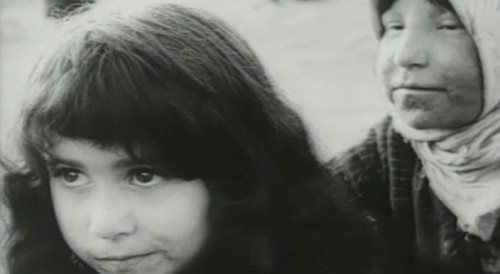Written by Rachael Johnson.
A film is never really good unless the camera is an eye in the head of a poet.
–Orson Welles
The Iranian feminist poet Forough Farrokhzad (1935-1967) led the way in both her life and art. Her pen foregrounded female subjectivity and desire while her independent lifestyle defied the gender norms of her time and place. Killed in a car accident at the tragically young age of 32, Farrokhzad is regarded as one of the great voices of 20th century Persian poetry. But the Tehran-born poet also occupies a special place in Iranian cinema. She wrote and directed The House is Black, an award-winning documentary short film that is still revered by Iranian filmmakers and well-respected by critics and scholars. A landmark essay film of Iranian New Wave Cinema, it recently secured a place (235) on Sight and Sound’s prestigious critics’ (2012) list of 250 Greatest Films.
The House is Black deserves all the critical acclaim it has received since its release in 1962. It is a powerful and rewarding film that should be more widely seen. It is also vital for critics, filmmakers, and lovers of cinema to remember and honor the work of women around the world who have made their mark in cinematic history. I acknowledge that some will find The House is Black a challenging viewing experience. It is a black-and-white documentary about a leper colony.
Forough Farrokhzad
Filming people afflicted by disease is, of course, potentially problematic. The leprous body has traditionally been a site of anxiety and fear in the cultural imagination and those suffering from the condition have suffered terrible prejudice. Are the victims of disease being violated and exploited by the camera? Is the viewer being emotionally manipulated? There is, thankfully, nothing exploitative about Farrokhzad’s documentary. Her gaze never debases her subjects. She depicts their everyday lives and recognizes that they are not only active members of their community but also a part of their country as well as the human family. We see them pray, collect food, play games, enjoy music, apply make-up, attend weddings, and care for their children. They are not characterized as “other.” Note, however, that Farrokzhad does not shy away from the condition. Her gaze is direct. She has a poet’s grasp of detail as well as a poet’s empathy. Visibility is, in fact, crucial to her project. The producer’s voice-over narration at the opening of the documentary states: “There is no shortage of ugliness in the world. If man closed his eyes to it, there would be even more. But man is a problem solver. On this screen will appear an image of ugliness, a vision of pain no caring human being should ignore. To wipe out this ugliness, and to relieve its victims is the motive of this film and the hope of its filmmakers.” Throughout the film, Farrokhzad’s camera records and honors the experiences of the most marginalized of people.
Farrokhzad does not put herself in the frame but she also employs her own evocative voice. In her voice-over narration, she reads from her haunting verse. The documentary, in fact, incorporates the scientific, metaphysical, sacred and lyrical. Farrokhzad’s poetry serves to articulate the suffering of the afflicted while images of men praying are interwoven with glimpses of patients being treated. A more extended montage of patients being treated is, also, supplemented by a medical voice telling us that leprosy is a contagious but “not incurable,” treatable condition.
The House is Black is a 20th century film about an ancient condition. It is not only expertly executed — there are some fine tracking shots — but it also highly innovative. The poet-director’s use of close-ups, rapidly edited, thematically connected images, as well as repetition of images, endow the documentary with a poetic richness and potency. Sadly, The House is Black is the only film the poet directed. Who knows what other wonderful work she would have given us. Nevertheless, we should be grateful for this utterly unique contribution to World Cinema.





